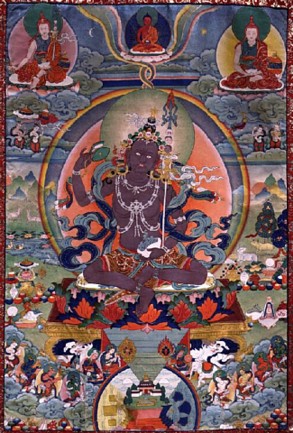Nyingtik Saldrön

Nyingtik Saldrön (Wyl. snying thig gsal sgron) 'The Lamp that Illuminates the Heart Essence' — a guru yoga practice composed by Jamyang Khyentse Chökyi Lodrö at the request of Tsering Yudrön, a princess of Derge, and Dilgo Khyentse Rinpoche. Of all the guru yoga practices that he composed, this is considered the most special. Jamyang Khyentse also wrote a commentary to the practice, called the Yeshe Saldrön.
Prayer of Invocation
It contains the following invocation:
- chi tar gyalsé chökyi lodrö jé
- In outer form you are the bodhisattva Lord Chökyi Lodrö,
- nang tar jampal trimé shenyen shyap[1]
- Inwardly, you are Manjushri and Vimalamitra,
- sangwa tsen dzok heruka pal la
- Secretly, you are the Glorious Heruka with perfect attributes,
- solwa depso dak gyü chin gyi lop
- Grant me the blessings to change my mindstream, I pray!
- Mantra for invoking the wisdom mind:
- om ah hung guru shri pema heruka sarwa siddhi pala hung[2]
Tibetan text
| This section contains Tibetan script. Without proper Tibetan rendering support configured, you may see other symbols instead of Tibetan script. |
|
༈ ཕྱི་ལྟར་རྒྱལ་སྲས་ཆོས་ཀྱི་བློ་གྲོས་རྗེ། ནང་ལྟར་འཇམ་དཔལ་དྲི་མེད་བཤེས་གཉེན་ཞབས། གསང་བ་མཚན་རྫོགས་ཧེ་རུ་ཀ་དཔལ་ལ། གསོལ་བ་འདེབས་སོ་བདག་རྒྱུད་བྱིན་གྱིས་རློབས། ཨོཾ་ཨཱཿཧཱུྂ་གུ་རུ་ཤྲཱི་པདྨ་ཧེ་རུ་ཀ་སརྦ་སིདྡྷི་ཕ་ལ་ཧཱུྂ། ། |
Commentaries
In Tibetan
- Jamyang Khyentse Chökyi Lodrö, Yeshe Saldrön (Tib. ཡེ་ཤེས་གསལ་སྒྲོན་; Wyl. ye shes gsal sgron), JKCL sungbum vol. II.
- Dilgo Khyentse Rinpoche, བསླབ་གྲོལ་ཡོན་ཏན་དགེ་བ་འཇམ་དབྱངས་རྒྱལ་མཚན་ལ་ཕུལ་བ།, bslab grol yon tan dge ba 'jam dbyangs rgyal mtshan la phul ba, Collected Works, vol. 3, pp. 467-470.
In English
- Jamyang Khyentse Chökyi Lodrö, Yeshe Saldrön, 'The Lamp that Illuminates Wisdom'.
- Dilgo Khyentse Rinpoche, A Letter of Advice for Practising The Bright Torch of the Innermost Essence.
Notes
- ↑ There are different versions of this line. Some editions have Tib. དང་ dang, but according to the Gangtok edition of Jamyang Khyentse's collected works, the line ends in Tib. ཞབས་ shyap (Wyl. zhabs). Alak Zenkar Rinpoche has confirmed that this is the correct version.
- ↑ Different versions of the mantra are given in different editions of the text. Some version omit the syllable pala (Wyl. pha la), although this appears to be a mistake as the syllable does appear in the commentary. In addition, the commentary mentions the syllable only hung once, when it appears at the end of the mantra.
